Hydrangea paniculata Polar bear - features of care and reproduction
In 2013, the Polar Bear hydrangea variety was introduced by Dutch breeders. It was created by crossing the popular varieties Grandiflora (Large-flowered) and Lime-light. From the first parent, the hybrid received large flowers, from the second - powerful, not drooping stems.
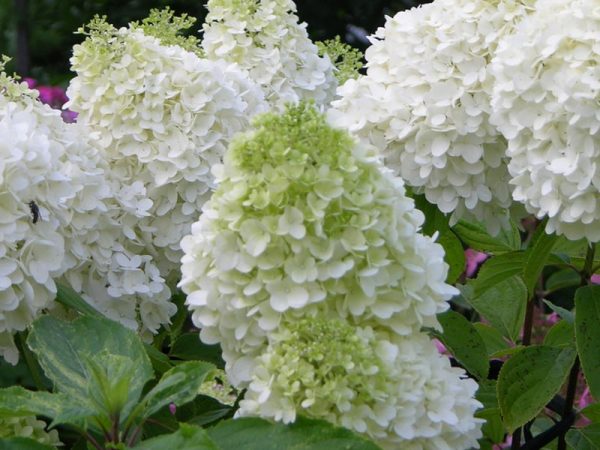
Hydrangea polar bear description
Description of the variety
Hydrangea paniculata Polar bear, she is Polar beer, Polar bear is one of the most spectacular representatives of the Hortensievs. The Latin name is hydrangea paniculata Polar Bear.
Powerful bushes, towering taller than human height, throw up huge caps of inflorescences the size of a man's head. Moreover, they are distinguished by high winter hardiness at the level of fruit trees, decorative qualities and longevity (40-50 years).
To make the plant look as spectacular as possible, it is pruned annually. Without pruning, the bush can grow up to 2.5 m in height and 1.5 m in width. Powerful stiff erect stems stretch to the sky, not drooping under the weight of flowers, even after a downpour.
The leaves are bright green at the top and lighter below, opposite, ovoid, pointed at both ends, with a hard surface and a serrated edge.
Well-groomed specimens, thanks to slender branches and lush flower stalks, resemble giant bouquets displayed in the middle of the garden.
The flowering period begins a little later than usual - in mid / late July. The process lasts until the end of September / October. Under favorable conditions there are so many flowers that they cover the bush from above with a dense cloud.
Panicle peduncles are conical in shape, reaching 40 cm in length. At the beginning of flowering, sterile flowers of white and pistachio color predominate. By the middle of the season, they become snow-white, and turn pink from below in the fall.
Large flowers, up to 3 cm, have 3-4 smooth petals, slightly twisted in the manner of a propeller.
Landing features
Although the Polar Bear variety is unpretentious, it puts forward special requirements for the quality of the soil. It will grow on any land. But to please with lush flowering - only on acidic, slightly moist, while well-drained soils.
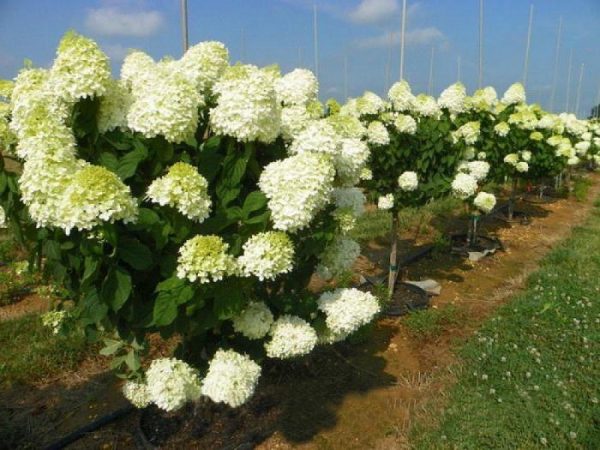
Hydrangea paniculata polar bear variety description
The ideal option is loam with an organic-rich upper fertile layer and a pH value of 5-6.
Timing
The best time for planting is March-April (depending on the climatic zone). Plants planted at this time manage to receive the whole complex of fertilizing and meet winter fully armed.
In principle, it can be planted during the entire growing season, but no later than a month before frost.
Seat selection
For tall hydrangeas, an illuminated area is suitable, located in the partial shade of a building, fence or neighboring trees.
The optimal time in direct light is 6 hours.The plant will be uncomfortable all day under direct sun, which will affect both the growth rate and the size of the inflorescences - they will decrease. In the shade, the hydrangea feels good (if there is no excess moisture), but the flowering intensity is much lower than possible.
Before planting, the place must be refined. Weed weeds, mow the lawn, remove excess flowers and bushes that interfere with growth. If there are a lot of slugs on the site, it is advisable to catch them using traps.
Preparation of planting material
When choosing cuttings, you need to pay attention to the root system and leaves. The roots must be well developed and the foliage must be free of mold.
Cuttings are often sold in pots. To identify rooted specimens, lightly pull on the top of the cutting. If resistance is felt, then the roots have already formed.
When choosing grown seedlings and mature bushes, it is necessary to check the roots for rot. If seedlings are offered in pots, look at the color of the foliage and the condition of the shoots. The former should be juicy, green, without yellow spots, and the latter should be firm, not wilted.
Landing technology
Polar Bear belongs to large hydrangeas, therefore a bigger hole is required: 50x50x50 cm. Many gardeners recommend shortening the roots before planting. Shards, gravel or expanded clay are placed on the bottom as drainage.
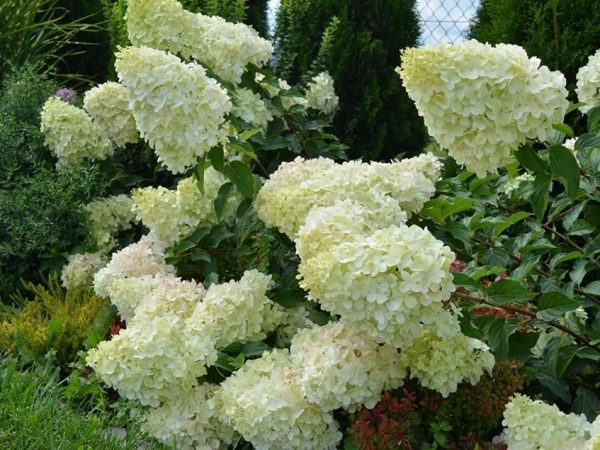
Buy hinget hydrangea polar bear
When planting, the root collar should not be buried in the ground. If the soil is poor, or excessively dense clayey, it is better to fill the well prepared substrate from a mixture of coarse river sand, sod (deciduous) soil and compost (peat) into the pit.
You can add additional fertilizer to the hole. After filling the soil, the earth is watered abundantly, lightly tamped, and then mulched.
Attention! It is impossible to use fine construction sand, lime, ash and coal for the preparation of the soil mixture.
Care
Polar Bear hydrangea responds with gratitude to care, but will grow, even if you do not pay attention to it. However, if the goal is to grow a beautiful bush, first of all, you need to properly plant the plant, equip drainage, periodically feed it and cut it off once a year.
Watering
Hydrangea has large, but thin leaves. Due to the large area of evaporation, the plant constantly needs an influx of moisture.
With a lack of water, the bush will not die, but it will lose its decorative qualities: the leaves will become brittle, there will be few flowers. The very name of the genus Hydrangea translates as "a vessel with water".
The Polar Bir variety is distinguished by its large forms. Accordingly, he needs more moisture. The weekly rate is 30 liters of water per bush. If it rains regularly, and the hole is covered with mulch, which slows down evaporation from the root zone, additional watering is not required.
Do not water with cold or hard water from the water supply. It must be collected in a container and defended for at least a day so that it warms up and the chlorine disappears. In ecologically clean regions, it is better to use rainfall, but in industrial cities, the rains can be polluted, acidic.
If the local water is hard, the pH should be lowered. For this, several methods are used:
- Defend for about a week and use only 2/3 of the volume, trying not to raise the calcium precipitate from the bottom of the container. For example, they are drained using an aquarium hose, without lowering its end to the bottom.
- Pass through drinking filters designed to reduce hardness. But their resource is limited.
- Boil or cool. Calcium will precipitate - it cannot be used.
- Add peat (in gauze, stocking) at the rate of 1 g per 1 liter and let it stand for several days.
Important! Hard water contains excess calcium carbonate. Once in the ground, it transforms into insoluble carbon dioxide limestone, which reacts with natural ground acids. The substrate becomes alkalized, which leads to a depressed state of hydrangeas, which love acidic soils.
Top dressing
All hydrangeas, without exception, are responsive to feeding.But not all dressings have a beneficial effect on the decorative qualities of flowers. You cannot use ash, coal, be careful with nitrogen-containing fertilizers. On fertile soils, the intensity of top dressing is less, on poor loams and sands - more.
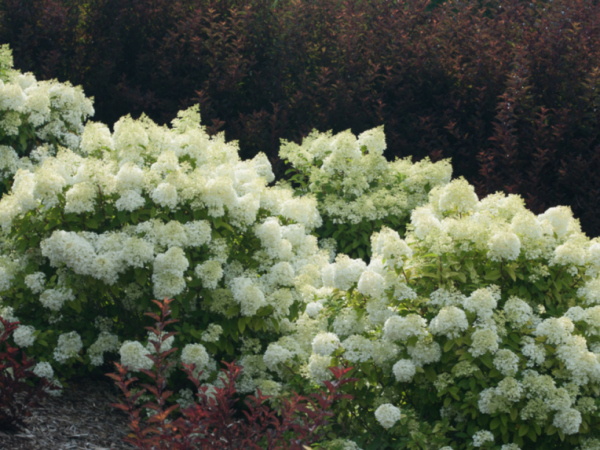
Hydrangea paniculata polar bear planting and care
The most important stage of feeding is in the spring at the beginning of the growing season. As a rule, organic fertilizers and immunomodulating drugs are used. By the time of budding, hydrangea depletes the reserves of trace elements in the soil; during this period, mineral fertilizers supplemented with superphosphates and urea are relevant. In July and August, it is useful to use mullein infusion once.
Pruning
It can be done in late fall or spring. The best time is at the end of February / March before sap flow. They remove dried panicles damaged by frost and diseases, crooked, thin stems growing inside the bush, root growth.
For flowering to be abundant, old skeletal branches are cut in half, or 2/3 of the length, leaving 3-5 buds from the ground. Every 5-6 years, a bush for rejuvenation is cut at the root, or 1/3 of the old branches are left.
Preparing for winter
Many domestic sites indicate that the plant can withstand 40-degree frosts. Although it is the "Polar Bear", it is not so strong. Without proper cover, the bush can be severely damaged in areas open to northerly winds, even at -15 ° C. But in general, the Polar Bear variety is considered one of the most winter-hardy (up to -25 ° C) among all Hortensievs.
First of all, due to the close to the surface of the roots, it is necessary to cover the root zone with mulch. Any organic matter (peat, leaf litter, hay, a mixture of rotted manure with straw, compost, moss) and covering material are used. Once a season, it is useful to use sawdust mixed with needles for protection - as they decompose, they will additionally acidify the soil.
In 3-4 climatic zones, the thickness of the mulch layer should be at least 20 cm.
Reproduction
Due to biological characteristics, hydrangea seeds do not retain their varietal qualities. Therefore, in the world for reproduction in domestic conditions, shoots are used, less often roots.
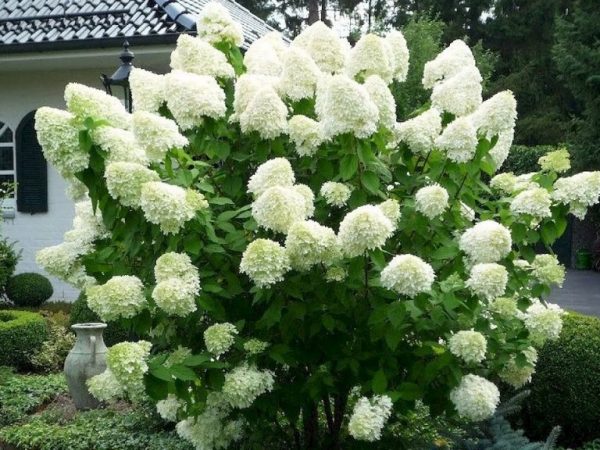
Caring for panicle hydrangea polar bear
Cuttings
The simplest and most effective method for propagating hydrangeas:
- Choose a one-year, non-woody shoot.
- The top of the head is cut vertically with a length of 10-15 cm.
- Tear off 1-2 pairs of lower leaves. The upper ones must remain intact.
- Put in a solution (for example, "Kornevin"), which accelerates root formation for the time specified in the instructions.
- They are planted in a fertile substrate for 1/3 of the length. Can be in flower pots, or in a flower garden Cuttings root better in a greenhouse.
Layers for reproduction
A young healthy shoot in mid-summer or early autumn is bent to the ground, fixed and instilled, leaving the upper part about 20 cm long on the surface.
Within a month, the root system will form, but it should be transplanted only next year, in the period from spring to early autumn, the shoot is separated from the mother bush and transplanted.
Rhizome division
This method is rarely used. Hydrangea roots are mostly thin. But even among them there are leading, thickened ones.
A large healthy root with a renewal bud is selected, cut and transplanted. Over time, their sleeping bud will sprout.
Diseases and pests
Polar Bear is considered disease resistant. Leaves can be favored by slugs and some types of snails. Unpleasant consequences are observed with an excess of moisture, lack of drainage, when grown in the shade in thickened plantings.
| Type of disease | Manifestation | Treatment |
| Bacterial wilting | Caused by the bacterium Pseudomonas solanacearum. It spreads with infected seeds, weeds, diseased plants, leaf beetles. | At the first sign, the fungicide "Coronet" is used. It is necessary to weed the weeds on time, not to plant flowers next to the pumpkin seeds (on which the bacteria thrive), to fight the Diabrotica and Acalymma leaf beetles. |
| Kidney rot | A withering condition caused by various types of bacterial and fungal pathogens. It develops when agricultural technologies are not followed: planting thickening, excessive watering, contact with infected plants. | It is treated with broad-spectrum bactericidal-fungicidal preparations ("Zerox"). |
| Leaf spots | They are caused by various pathogens: viruses, bacteria, fungi. At a low level of spread, they do not have a negative impact. | Some recommend spraying mullein infusion in June and re-spraying in July. With a moderate manifestation, use "Fitosporin-M", "Gamair", "Baktofit". With strong - alternate (no more than 3 times) treatment with an interval of 10-12 days with preparations based on triazole and mancozeb. Immunomodulators help to strengthen plants: "Immunocytophyte", "Epin", "Zircon". In the fall, be sure to remove plant litter, spray the ground and bush with 3% copper sulfate. |
| Rust | A dangerous contagious fungal disease that is difficult to treat. It leads to a loss of moisture, so necessary for hydrangeas, disrupts photosynthesis, and reduces decorative qualities. Sometimes the plants die. It develops more often in thickened plantings in cool, important weather, as well as with an excess of nitrogen in the soil. | Treatment consists in the destruction of the affected parts of the plant and subsequent treatment with 1% Bordeaux liquid, sulfur-containing drugs, fungicides (Fitosporin-M, Topaz, Baktofit, Abiga-Peak). |
| Mold | There are many fungal diseases affecting roots, leaves, flowers, stems, buds, and buds. These are frequent companions of waterlogging of the soil. | Before planting hydrangeas, it is highly recommended to equip drainage in the root zone. Fungi often develop on plants growing in the shade, in thickening, heaps of debris. Before planting, it is useful to spill the soil with a solution of potassium permanganate or biofungicide. But ash or charcoal should not be used, so as not to reduce the acidity of the soil. A wide range of fungicides is available to combat fungi. The solution shows good results: for 1 liter of water add 5 g of copper sulphate, drugs "Actellik" and "Decis" with a dosage according to the instructions. |
Use in landscape design
The powerful bushes of the Polar Bear are ideal for solo planting in the middle of a mowed lawn. When growing in tubs, you can periodically change its location, experimenting with landscape design. But in containers, the size of the inflorescences may be smaller, and for the winter they will have to be cleaned indoors.
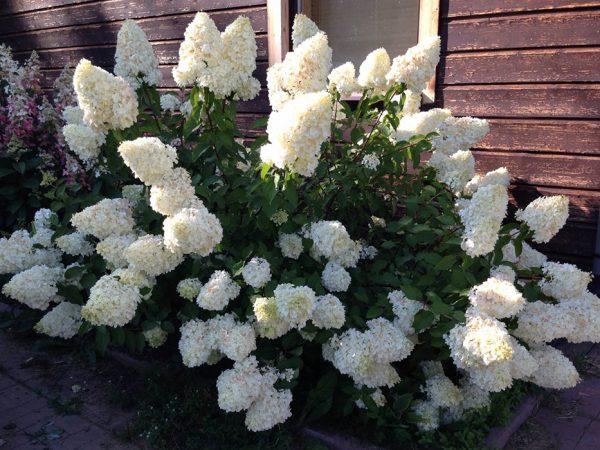
Planting a hydrangea paniculata polar bear
The hydrangea looks interesting in a flower arrangement when stunted flowers, cereals, dwarf cedar, dwarf thuja are planted around it.
In botanical gardens and in large garden plots, you can find amazing mixboards, where the plant is combined with conifers and rhododendrons. They complement each other in different seasons of the year.
But most often, the Polar Bear variety is used to create decorative hedges both in mono-plantings and in combination with hydrangeas of a different color.
Gardeners reviews
Although Polar Bir is a relatively new variety, it is already known in Eastern Europe. Many amateur gardeners have acquired bushes, but it is too early to draw final conclusions. Most specimens are less than 5 years old. Indeed, the variety grows well in the middle lane and blooms, but not everyone succeeds in reaching record 40-centimeter inflorescences. It is curious that some growers manage to grow specimens with peduncles 45 cm long - this is more than the breeders claim.
Good winter hardiness. Even if the bush freezes a lot, after winter new shoots appear and the plant recovers within a year. But still, additional shelter will not hurt, at least by mulching the root zone. The plant pleases with decorativeness. The stems are tough, strong, they themselves practically do not break, do not bend to the ground.Dried flowers cut before winter retain their shape for a long time.

